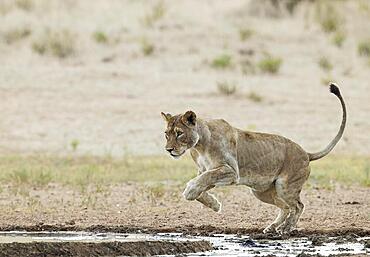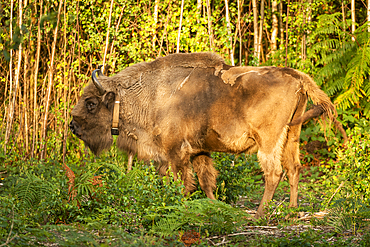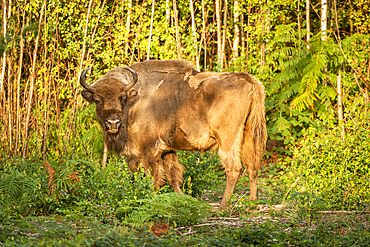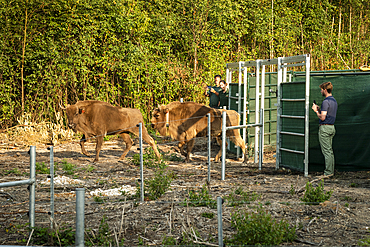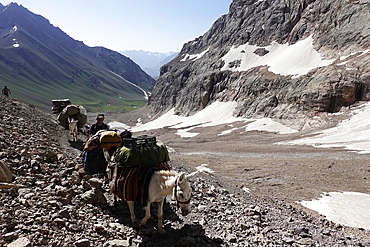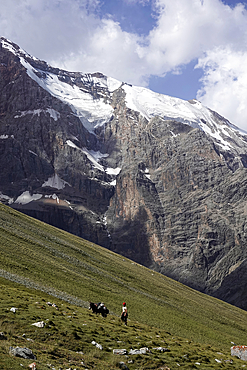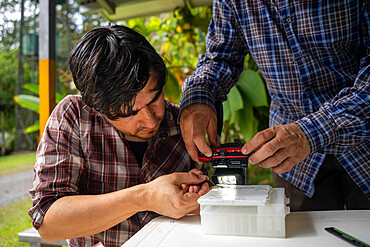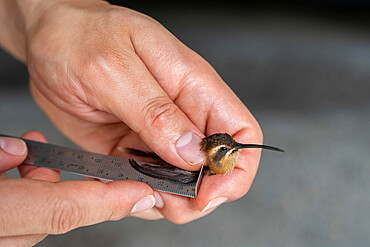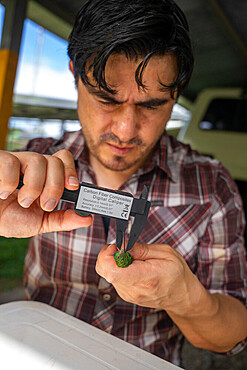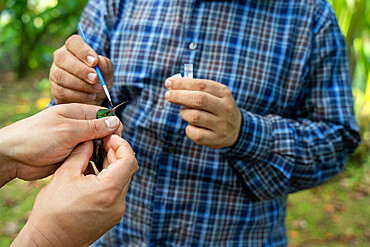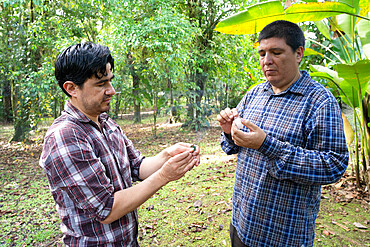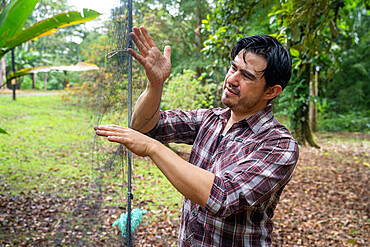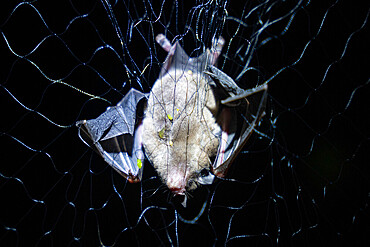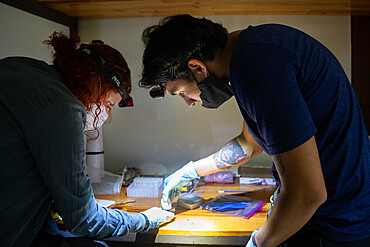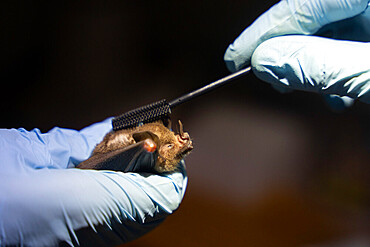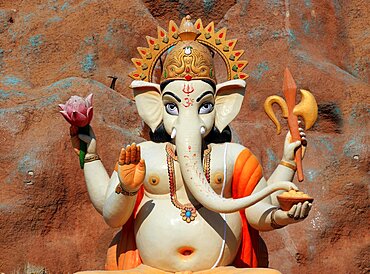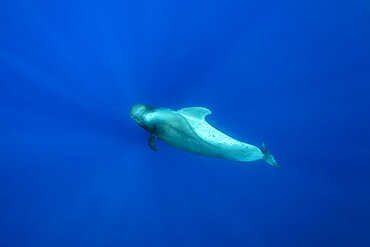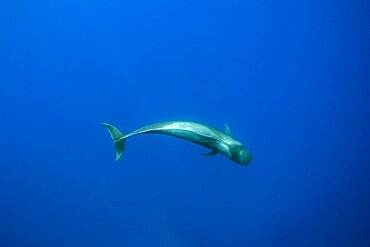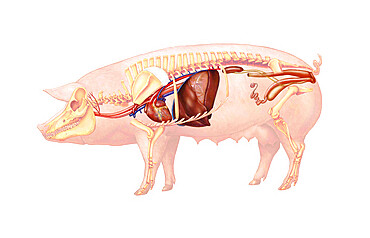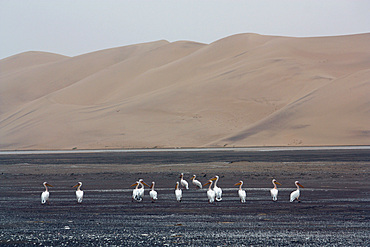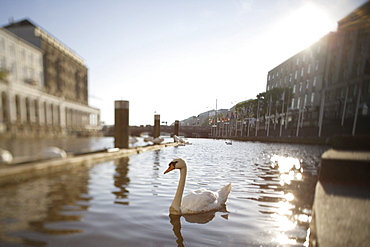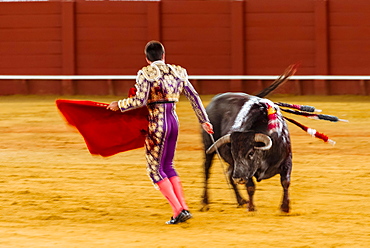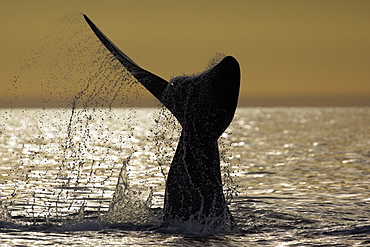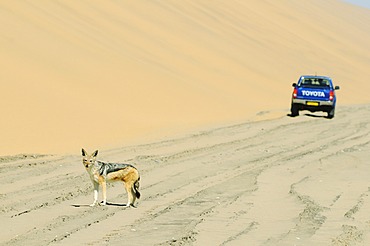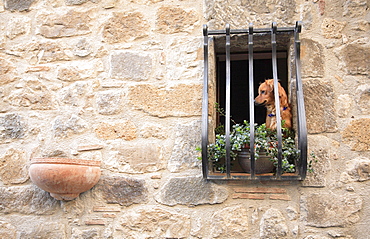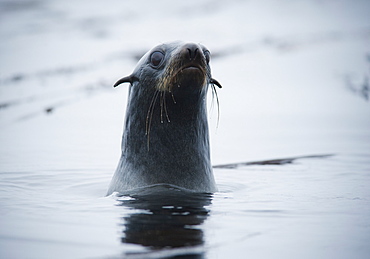Recent searches
Loading...
832-403326 - Lion (Panthera leo) . Female. Jumping over the muddy part of a waterhole. Kalahari Desert, Kgalagadi Transfrontier Park, South Africa, Africa
1200-553 - European Bison (Bison bonasus), female (cow), being released into woodland as part of the Wilder Blean project, Kent, England, United Kingdom, Europe
1200-552 - European Bison (Bison bonasus), female (cow), being released into woodland as part of the Wilder Blean project, Kent, England, United Kingdom, Europe
1200-551 - European Bison (Bison bonasus), female (cow), being released into woodland as part of the Wilder Blean project, Kent, England, United Kingdom, Europe
1200-550 - European Bison (Bison bonasus), female (cow), being released into woodland as part of the Wilder Blean project, Kent, England, United Kingdom, Europe
802-701 - The remote and spectacular Fann Mountains, part of the western Pamir-Alay, Tajikistan, Central Asia, Asia
802-692 - Pack animals in the remote and spectacular Fann Mountains, part of the western Pamir-Alay, Tajikistan, Central Asia, Asia
802-684 - The remote and spectacular Fann Mountains, part of the western Pamir-Alay, Tajikistan, Central Asia, Asia
802-678 - The remote and spectacular Fann Mountains, part of the western Pamir-Alay, Tajikistan, Central Asia, Asia
802-675 - Pack animals in the remote and spectacular Fann Mountains, part of the western Pamir-Alay, Tajikistan, Central Asia, Asia
1112-7655 - Egyptian Guide in Saqqara, part of the Memphite Necropolis, UNESCO World Heritage Site, Egypt, North Africa Africa
860-291442 - Researcher photographing a 2.6 gram Stripe-throated Hermit hummingbird as part of a pollination study, rainforest at the "La Selva" research station in Puerto Viejo de Sarapiqui, Costa Rica
860-291441 - Researcher measuring a 2.6 gram Stripe-throated Hermit hummingbird wing as part of a pollination study, rainforest at the "La Selva" research station in Puerto Viejo de Sarapiqui, Costa Rica
860-291439 - Researcher measuring the beak of a Rufous-tailed hummingbird as part of a pollination study, rainforest at the "La Selva" research station in Puerto Viejo de Sarapiqui, Costa Rica
860-291440 - Researchers picking up pollen with a brush from the beak of a hummingbird Stripe-throated Hermit as part of a pollination study, rainforest at the "La Selva" research station in Puerto Viejo de Sarapiqui, Costa Rica
860-291438 - Researchers picking up pollen with a brush from the beak of a Rufous-tailed hummingbird as part of a pollination study, rainforest at the "La Selva" research station in Puerto Viejo de Sarapiqui , Costa Rica
860-291437 - Researchers picking up pollen using tape on the beak of a Rufous-tailed hummingbird as part of a pollination study, rainforest at the "La Selva" research station in Puerto Viejo de Sarapiqui, Costa Rica
860-291434 - Researcher setting up a net to capture hummingbirds as part of a pollination study, rainforest at the "La Selva" research station in Puerto Viejo de Sarapiqui, Costa Rica
860-291435 - Rufous-tailed Hummingbird (Amazilia tzacatl) in a net set up by a researcher as part of a pollination study, rainforest at the "La Selva" research station in Puerto Viejo de Sarapiqui, Costa Rica
860-291433 - Fringe-lipped Bat (Trachops cirrhosus) in the hand of a scientist as part of a pollination study, tropical forest at the "La Selva" research station in Puerto Viejo de Sarapiqui, Costa Rica
860-291432 - Bat caught in a net as part of a pollination study, rainforest at the "La Selva" research station in Puerto Viejo de Sarapiqui, Costa Rica
860-291431 - Researcher unhooking a bat caught in a net as part of a pollination study, rainforest at the "La Selva" research station in Puerto Viejo de Sarapiqui, Costa Rica
860-291430 - Researchers applying a mascara brush to the hairs of a Sowell's short-tailed bat (Carollia sowelli) to test methods to capture pollen that bats may carry as part of a pollination study, rainforest at the "La Selva" research station in Puerto Viejo de Sarapiqui, Costa Rica
860-291427 - Researchers applying tape to the hairs of a bat to test methods to capture the pollen it carries as part of a pollination study, rainforest at the 'La Selva' research station in Puerto Viejo de Sarapiqui, Costa Rica
860-291428 - Researchers applying a mascara brush to the hairs of a Sowell's short-tailed bat (Carollia sowelli) to test methods to capture pollen that bats may carry as part of a pollination study, rainforest at the "La Selva" research station in Puerto Viejo de Sarapiqui, Costa Rica
860-291426 - Sowell's short-tailed bat (Carollia sowelli) caught as part of a pollination study, rainforest at the "La Selva" research station in Puerto Viejo de Sarapiqui, Costa Rica
860-291425 - Sowell's short-tailed bat (Carollia sowelli) caught as part of a pollination study, rainforest at the "La Selva" research station in Puerto Viejo de Sarapiqui, Costa Rica
832-398548 - Sleepy French Bulldog with birthday part hat in front of blurry blue background with garlands and party streamers
1242-500 - Releasing newly hatched green sea turtles at Playa Bacocho as a part of a local rescue project, Oaxaca, Mexico, North America
832-397490 - Rajasthan, Vatshmo Mata Temple, new modern temple on the road from Mandawa to Bikaner, part of the temple complex with elephant god, sacred animal, North India, India, Asia
832-397491 - Rajasthan, Vatshmo Mata Temple, new modern temple on the road from Mandawa to Bikaner, part of the temple complex with elephant god, sacred animal, North India, India, Asia
860-291100 - Squids regurgitated by a Short-finned pilot whale (Globicephala macrorhynchus) one of the two species of cetaceans in the genus Globicephala, which it shares with the long-finned pilot whale (G. melas). They are part of the oceanic dolphin family (Delphinidae). Terceira island, Azores, Portugal, Atlantic Ocean
860-291098 - Short-finned pilot whale (Globicephala macrorhynchus) one of the two species of cetaceans in the genus Globicephala, which it shares with the long-finned pilot whale (G. melas). They are part of the oceanic dolphin family (Delphinidae). Terceira island, Azores, Portugal, Atlantic Ocean
860-291101 - Short-finned pilot whale (Globicephala macrorhynchus) one of the two species of cetaceans in the genus Globicephala, which it shares with the long-finned pilot whale (G. melas). They are part of the oceanic dolphin family (Delphinidae). Terceira island, Azores, Portugal, Atlantic Ocean
832-395192 - Leafcutter ant (Atta cephalotes) transports part of a leaf, Serere Eco Reserve, near Rurrenabaque, Beni district, Bolivia, South America
832-395193 - Leafcutter ants (Atta cephalotes) transport parts of leaves, Serere Eco Reserve, near Rurrenabaque, Beni District, Bolivia, South America
1348-5365 - Anatomy of a sow. From left to right: the heart, the digestive system with liver, pancreas, spleen and stomach. Underneath the ureters and from left to right : ovaries, oviducts, uterus and vagina. Above, the terminal part of the digestive tube (colon) with the rectum.
1113-107200 - Angola; southern part of Namibe Province; Iona National Park; Baia dos Tigres; small seal on the beach
1113-106841 - Angola; in the southern part of Namibe Province; northern part of the Namib Desert; Baia dos Tigres; Atlantic coast; Seal on the beach
1113-107004 - Angola; southern part of Namibe Province; Iona National Park; Pelicans in the Baia dos Tigres;
1116-50258 - Wood bison bull (Bison bison athabascae) portrait, Alaska Wildlife Conservation Center in South-central Alaska. The Alaska Wildlife Conservation Center played a big part in helping reintroduce these animals back into the Alaska wilds; Portage, Alaska, United States of America
1113-104204 - Swan on Alsterfleet part of river Alster, , Alster Arcades left, , Hamburg, Germany
1184-3538 - Governors Beach, part of Seven Mile Beach, Grand Cayman, Cayman Islands, Caribbean, Central America
1317-8 - A fishing trawler at sea, taking part in the annual whale festival, with a lion dance on deck and other boats in the background, Vietnam, Indochina, Southeast Asia, Asia
1225-1329 - Busy market streets in the old part of Kathmandu called Ason, Kathmandu, Nepal, Asia
832-382825 - Racing bull with Matador, Torero or Toureiro in traditional dress, third part, so-called Faena, bullfighting, bullring Plaza de Toros de la Real Maestranza de Caballeria de Sevilla, Sevilla, Andalusia, Spain, Europe
832-381734 - Fluke of a Sperm Whale (Physeter macrocephalus) while diving, Kaikoura, Canterbury Region, New Zealand, Oceania
1116-39724 - A Harlequin Shrimp (Hymenocera elegans) holding part of a blue seastar (Linkia laevigata) which it will feed on, Philippines
1116-40765 - Cowboy Boot Heel And Spur In Saddle Stirrup
764-5928 - Cape Gannet (Morus capensis) pair necking as part of courtship, Bird Island, Lambert's Bay, South Africa, Africa
746-88104 - Atlantic Puffin (Fratercula arctica) in a puffinry on Mykines, part of the Faroe Islands in the North AtlanticDenmark, Northern Europe
746-88103 - Atlantic Puffin (Fratercula arctica) in a puffinry on Mykines, part of the Faroe Islands in the North Atlantic. Catch of fish sandeel in its beak, Denmark, Northern Europe
746-88389 - Transhumance, the great sheep trek across the main alpine crest in the Otztal Alps between South Tyrol, Italy, and North Tyrol, Austria. This very special sheep drive is part of the intangible cultural heritage of the austrian UNESCO Commission. Fair at Kurzras with traditional folk music, food and drinks for the herders and the tourists. Alpenhorn played by mountain farmers in their traditional blue skirt, Europe, Central Europe, Italy
746-88105 - Landing in a colony. Atlantic Puffin (Fratercula arctica) in a puffinry on Mykines, part of the Faroe Islands in the North Atlantic, Denmark, Northern Europe
746-88096 - Atlantic Puffin (Fratercula arctica) in a puffinry on Mykines, part of the Faroe Islands in the North Atlantic, Denmark, Northern Europe
746-88095 - Atlantic Puffin (Fratercula arctica) in a puffinry on Mykines, part of the Faroe Islands in the North Atlantic, Denmark, Northern Europe
746-88094 - Atlantic Puffin (Fratercula arctica) in a puffinry on Mykines, part of the Faroe Islands in the North Atlantic. Catch of fish (sandeel) in its beak, Denmark, Northern Europe
832-374363 - Hands holding spawn of Common frog (Rana temporaria)
832-368883 - Leaf Chameleon (Brookesia tuberculata), Montagne d'Ambre National Park, Madagascar, Africa, Indian Ocean
832-372606 - Two people are trying to feed a bat (Microchiroptera) with a syringe
832-374883 - Young Chimpanzee (Pan troglodytes), baby, Mahale Mountains National Park, Tanzania, East Africa, Africa
832-372326 - Off-road vehicle and a Black-backed jackal (Canis mesomelas) near Sandwich Harbour, Namib Naukluft National Park, part of the Namibian Skeleton Coast National Park, Skeleton Coast, Namib Desert, Namibia, Africa
832-348466 - Dog in the old part of town, Bolsena, Latium, Italy
832-320141 - Tanned and dyed animal skins, spread out on the pavement for drying, historic Medina quarter, Marrakesh, Morocco, Africa
465-3137 - Honey bee, Apis mellifera feeding on Echinacea sp., or cone flower nectar. Honey bees are in trouble in many parts of the world but are doing well in urban areas where their exposure to pesticides, insecticides and fungicides is limited. Photographed in London, UK garden.
832-240625 - Timbered house with cattle painted on the front, Old Town, Arbon, Canton Thurgau, Lake Constance, Switzerland
238-6445 - Palm civet being fed coffe beans, part of the process of producing kopi luwak from the seed harvested from the civet droppings, Ubud, Bali, Indonesia, Southeast Asia, Asia
1161-1135 - A striated Caracara bird on Sea Lion Island - part of the Falkland Islands in the South Atlantic Ocean
869-4585 - ichneumon wasp front part head and thorax top shot Germany Europe
832-129666 - Hotel and restaurant in the historic district, Dinkelsbuehl, administrative district of Ansbach, Middle Franconia, Bavaria, Germany, Europe
832-122820 - Traboule Maison des Avocats, Saint Jean district, historic district of Vieux Lyon, UNESCO World Heritage, Lyon, France, Europe
832-102910 - Elephant feet, hunting trophies in the Reunification Palace, Reunion Hall, former seat of government, Ho Chi Minh City, Saigon, South Vietnam, Vietnam, Southeast Asia, Asia
857-62544 - Corn for animal feed grown on a small rural farm that is part of a cooperative of local farmers who grow medicinal herbs and other organic products in and around the small community of Turvo, central Parana state, Brazil.
832-19460 - Baobab tree (Adansonia digitata) and African Elephant (Loxodonta africana) in the savannah Tarangire National Park Tanzania
832-29155 - European Mole Cricket (Gryllotalpa gryllotalpa) on a child's hand
832-19457 - Giraffe (Giraffa camelopardalis) with long tongue feeds on Kigelia tree (Kigelia africana) in the savannah Tarangire National Park
1196-111 - The idea of the interconnectedness of all things is central to the tribal way of looking at the world. practical knowledge of the environment, of crops and medicines, of hunting and fishing, is a byproduct of it. the makuna believe that human beings, animals, and all of nature are parts of the same one. animals and fish live in their own communities, which are just like human communities, with their chiefs, their shamans, their dance houses, their songs, and their material possessions. when human peoples dance in this world, the shaman invites the animal people to dance in theirs. if humans do not dance and shamans do not offer spirit food to the animal people, the animals will die out and there will be no more game left in the world. for the makuna the radical disjunction so characteristic of western thought between nature and culture, men and animals, dissolves. eastern colombia amazon, vaupes region, population: 600
1196-66 - These reindeer peoples' entire existence is based around their herds of reindeer, which provide milk, skins for clothes, horn for carving and medicine, transport and occasionally, meat. the tsaatan are part of the tuvan ethnic group, which inhabits the tuvan republic of russia. there are only about 200 tsaatan in total, spread over 100,000 sq km of northern mongolia. they are nomadic, often moving their small encampments every three to four weeks, searching for special types of grass and moss loved by the reindeer. the tsaatan are strong practitioners of shamanism. west taiga, northern mongolia
978-336 - Manta Birstris showing cleaning station activity. Observations part of porject elasmo, conservation project in Ecuador.
978-361 - Subsistence farming is a large part of rural Ecuador.
978-321 - Manta Birstris showing cleaning station activity. Observations part of project elasmo, conservation project in Ecuador.
978-307 - Manta Birstris showing cleaning station activity. Observations part of porject elasmo, conservation project in Ecuador.
978-299 - Manta Birstris showing cleaning station activity. Observations part of porject elasmo, conservation project in Ecuador.
978-310 - Manta Birstris showing cleaning station activity. Observations part of project elasmo, conservation project in Ecuador.
917-219 - Rough-toothed Dolphin, Steno bredanensis, surfacing with part of a Dorado, Coryphaena hippurus, in itÃs mouth, Costa Rica, Pacific Ocean. This species of Dolphin is known to prey on large fish such as Dorado.
917-293 - Central American Spinner Dolphin group (Stenella longirostris centroamericana) part of a super pod of over 2,000 individuals, image taken from above the waters surface. Costa Rica, Pacific Ocean.
917-292 - Central American Spinner Dolphin group (Stenella longirostris centroamericana) part of a super pod of over 2,000 individuals, image taken from above the waters surface. Costa Rica, Pacific Ocean.
917-386 - Northern Bottlenose Whale (Hyperoodon ampullatus) three adult animals surfacing, rare unusual image. Azores, Atlantic Ocean. MORE INFO: This was part of a group of 13 animals seen South of Pico Island, it is extremely rare to see so many Bottlenose Whales together.
921-767 - Wild Large Male Northern fur seal ( Callorhinus ursinus ), Solo, In water, Endangered, part of massive colony. Srednego Island (Bering Sea), Russia, Asia
921-845 - Wild Large Male Northern fur seal ( Callorhinus ursinus ), Solo, In water, Endangered, part of massive colony. Srednego Island (Bering Sea), Russia, Asia
917-171 - Central American Spinner Dolphins, Stenella longirostris centroamericana, this is part of a super-pod of over 2,000 individuals, Costa Rica, Pacific Ocean.
917-291 - Central American Spinner Dolphin group (Stenella longirostris centroamericana) part of a super pod of over 2,000 individuals, image taken from above the waters surface. Costa Rica, Pacific Ocean.
921-843 - Wild Large Male Northern fur seal ( Callorhinus ursinus ), Solo, In water, Endangered, part of massive colony. Srednego Island (Bering Sea), Russia, Asia
921-737 - Wild Large Male Northern fur seals ( Callorhinus ursinus ), Colony, Endangered, part of massive colony, being territorial, Tyuleniy Islands (Bering Sea), Russia, Asia.
917-172 - Central American Spinner Dolphins, Stenella longirostris centroamericana, this is part of a super pod of over 2,000 individuals, Costa Rica, Pacific Ocean.
